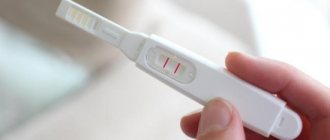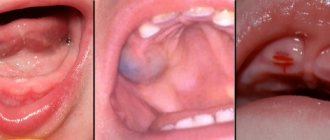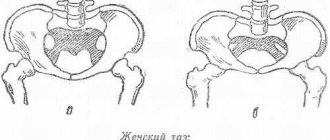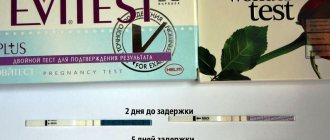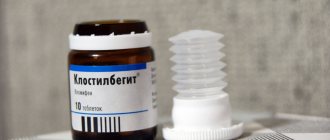The female menstrual cycle is not only about “red days of the calendar”; this is the path of the egg from the follicle (also victorious if sperm come across the path of our “beauty”). In general, ovulation.
Whether you want to get pregnant or not, you need to know about your ovulation lines. This is not difficult: in most cases, ovulation occurs 2 weeks before the start of menstruation. Although, of course, if your goal is to postpone the birth of your baby until next year, you should not trust this approximate figure.
One of your friends may have a cycle of 40 days, another - of 28, and all this is within the normal range. Naturally, each will have her own personal egg release day. The best way to determine it is either a purchased test or basal temperature.
Early and late ovulation
Ovulation does not always occur strictly according to the doctor’s calendar. Late, as you might guess from the name, is a late egg that decided to get out of the follicle 10 or 8 days before the start of menstruation. The early one is early ripening, ripening within 7 days after the end of the “red days”. All this is also within the normal range.
This phenomenon may occur due to:
- constant stress or nervous character of the lady,
- strict “weight loss” diet,
- bad habits,
- colds, infections, advanced or chronic diseases,
- hormonal imbalance,
- passion for a healthy lifestyle and simply an active lifestyle.
Beginning at 10, 13, and less often at 17 years old, ovulation continues until menopause (pausing only during pregnancy and breastfeeding - that is, until the young mother gets her period). If a non-pregnant woman does not ovulate, this is a bad sign and you should immediately go to the doctor. After all, even if you don’t want a child now, in a year or three you will definitely start waiting for a stork!
Briefly about what it is
Ovulation is the process of the release of a mature egg from the ovary. At the same time, it ruptures the follicle and moves towards the funnel of the fallopian tube, which captures it with its cilia and pulls it inside itself. This is where fertilization must occur.
Approximately once a month in the body of a woman of reproductive age, one of the ovaries releases an egg ready for fertilization, which is sent to the fallopian tube, where, under favorable circumstances, live sperm should await it (once in the woman’s body, sperm can remain viable for 3-6 days).
At this time, the mucous membrane of the uterus gradually thickens and prepares to receive a fertilized egg. If conception does not occur, then part of the mucous membrane is torn away and, along with the blood, is thrown out of the body - menstruation occurs.
How to determine the onset of ovulation?
A real hormonal shock occurs in the body, so that even the temperature of the internal organs changes (it can be checked using a rectal thermometer). Every day, measuring this temperature (it is called basal), mark the data on the graph - the time the scale jumps will show you ovulation. But you can’t part with the thermometer for several months.
A more convenient way is several ultrasound sessions showing changes in your body.
Read more about how to determine ovulation in our special article.
Ovulation stimulation
What to do if there is no ovulation? In this case, the doctor decides to stimulate the woman’s ovaries. One of the simplest methods is to take hormonal contraceptives for about three months. The ovary goes into hibernation, and then begins to work with redoubled force. Unfortunately, sometimes this method may not work.
In this case, the doctor prescribes more serious hormonal medications and injections. During the period of stimulation, some side effects may occur - increased appetite, tearfulness, irritability. To carry out stimulation, you need to undergo a series of studies.
- Complete blood count, blood tests for sugar, blood clotting, as well as HIV, hepatitis and syphilis. Both partners undergo tests.
- Study of thyroid function.
- Swabs from the genital tract for the presence of STDs. Both partners also rent.
- Breast ultrasound
- Oncological analysis of scrapings from the cervix.
- Tubal patency test
- Study of male sperm viability.
- Examination of the uterine cavity for inflammation.
Before stimulation, it is imperative to tell the doctor about all previous diseases.
How to prepare the body for stimulation.
Preparation for stimulation consists of carrying out all the necessary studies. However, it is worth preparing the body a little for such an intervention.
First of all, you should improve your nutrition. The menu should be balanced. It is necessary to completely eliminate alcohol and cigarettes. Reduce consumption of sweet, spicy, fatty and smoked foods. You should add as many fresh fruits, vegetables, and dairy products to your diet. You need to drink a lot of water.
What determines the time of ovulation?
Having your periods come on time is, although not one hundred percent, a sign of women’s health. It’s not scary if a young woman has one or two “idle” cycles per year (with an unripe egg). The older you get, the more such cases will occur. In some cases, a woman may have two eggs mature at once.
Female ovulation (as well as its hormonal bouquet) depends on:
- ecology,
- constant mood,
- nutrition,
- lifestyle,
- medicines.
Unless otherwise specified, the default time of ovulation is considered to be the middle of the month between the “critical days”. Do you want to have a baby? Buy sexy lingerie exactly on the 14th day after your last period.
If you are planning a second child, remember that your cycle may change over time due to:
- abortion (or several),
- experienced surgery,
- childbirth,
- ectopic pregnancy,
- the imminent approach of menopause.
If ovulation does not occur...
If the long-awaited ovulation does not occur, this may indicate serious problems with women’s health. Read more in the article - Why is there no ovulation and how to treat its absence?
Ovulation and conception
Gamete maturation is monitored primarily by women who want a child. Monitoring ovulation allows you to get pregnant on time, because in a woman’s cycle only two days are considered the most effective for human reproduction. If you do not yet know how many days after ovulation a child is conceived, then keep in mind that the fused sex cells descend into the uterine cavity within three days and become fixed there.
You will be interested to know how to conceive a girl and how to conceive a boy.
You need to track the moment the gamete exits into the cavity of the fallopian tube and perform sexual intercourse, as a result of which the sperm will enter the cavity of the uterus and fallopian tube, where conception will occur. Before this, you and your partner will need to undergo a comprehensive examination to identify problems with reproductive health. Even if you had intercourse on the day of ovulation, pregnancy may not occur due to the low quality of your partner's sperm or due to the presence of sexual diseases.
We hope that our article was informative for you, and you found out for yourself what ovulation is in the female body and how long it lasts.
Pregnancy planning Health Conception
How long does ovulation last?
This is almost a volcanic eruption, like a small splash in one of the ovaries. No scientist can calculate exactly when it will begin - the body itself decides when the egg matures. After exiting, she proudly follows into the fallopian tube, where, with the steadfastness of Princess Rapunzel, she awaits her prince in the tower. Ovulation is completed successfully if a crowd of sperm “barges in” on a date, and the bravest and most dexterous one fertilizes her.
To approximately predict the release of an egg, you need to do tests for HL (lutenizing hormone). During the rupture of the follicle, it accumulates in the body in especially large quantities, and can be detected both in the urine and in the blood.
The time of ovulation varies from woman to woman – it can happen in either 16 or 48 hours. Although on average (almost all medical literature refers to these figures), ovulation takes place in a full day, that is, in 24 hours.
If you are taking precautions, remember: sperm are so tenacious that they can “ambush” your body and wait for several days for the princess-egg.
How does the process work?
Even during intrauterine development in girls, during the formation of the genital organs, a certain number of eggs are laid, approximately about a million. Beginning with the first menstruation and throughout the childbearing years, one egg usually matures each cycle.
The answer to the question of how many days a woman’s menstrual cycle lasts depends on the individuality of her body. Basically, this is a period from 21 to 34-35 days, however, there are completely healthy women whose cycle does not fit into the specified period. From the first days of the cycle, the process of maturation of the egg begins in one of the ovaries: a dominant follicle is determined, the size of which is larger compared to the rest of the follicles. Every day it increases and, having reached 22-25 mm in diameter, ruptures under the influence of luteinizing hormone (LH), releasing a mature egg into the abdominal cavity, from where it enters the fallopian tube. This is how ovulation occurs.
It is generally accepted that ovulation processes occur approximately in the middle of the cycle, i.e. 12-16 days before the start of the next menstruation.
But it is worth considering that for every woman, even with a regular cycle, ovulation can shift, be early or late. This is influenced by many factors, such as stressful situations, previous acute respiratory infections or acute respiratory viral infections, hypothermia, active physical activity, frequent sexual intercourse, etc.
In addition, in an absolutely healthy woman, ovulation does not occur at all for several cycles a year. Such cycles are called anovulatory. The dominant follicle does not rupture, develops into a follicular cyst and usually regresses within 1-3 cycles. After the follicle ruptures and the egg enters the fallopian (uterine) tube, a corpus luteum forms in its place, which actively produces progesterone, which prepares the uterus for the possible implantation of a fertilized egg.
Continuing to move along the fallopian tube to the uterus, the egg waits for union with the sperm. If fertilization does not occur within 24 hours from the moment of ovulation, the egg dies and is released during the next menstruation along with the no longer needed endometrial layer.
Considering the number of days ovulation lasts, namely that the viability period of the egg varies about 24 hours, and by determining the time of ovulation, you can significantly increase your chances of getting pregnant.
Ovulation cycle
Your monthly cycle consists of the following periods:
- Your stomach hurts and bleeds: hurray, your “favorite” day, the 1st day of your period. This is the time to “launch” a new menstrual cycle. Meanwhile, the follicle began to mature...
- The next very “pleasant” week in your life is the ovulatory phase. A follicle emerges with a princess egg inside.
- Another two weeks passed and the follicle burst. The egg went deep into the tubes for 24-48 hours - ovulation began. Women planning a pregnancy say: they conceived a baby on the 5th day after the ovulation test gave the go-ahead.
- Corpus luteum phase: everything that remains of the ruptured follicle gathers into a lump, overgrown with fats (which is why the body is called yellow) and LH.
Ways to calculate ovulation
Identifying the timing of the ovulation process is important for couples who want to conceive a child, or for the fair sex herself, since this is the main indicator of her reproductive rate. If the regulation is stable, methods of measuring basal temperature or pharmacy tests are allowed. A regular cycle (monthly) indicates the absence of diseases in the sexual sphere. It can also be considered normal when ovulation stops during menopause up to the 12th month: it depends on age. It is also possible for cells to mature twice during one menstrual cycle.
Many experts offer their own calculation methods: mid-cycle, about two weeks before the first day of menstruation. The calculation is completely generalized , because the body is individual. Mostly, the beginning of the release of the egg occurs in the middle of the cycle - this is the 12-15th day from the last menstruation (from the 1st day). Having the data, you can calculate when pregnancy is most likely to occur.
During ovulation, the body experiences hormonal stress that affects basal temperature. It is easy to identify the day of interest based on this feature. Until the required period, temperature indicators decrease, and after a day they increase again. Those planning a pregnancy should pay attention to such things, know the ovulation days according to the basal temperature chart . In order to determine the ovulation period, they resort to ultrasound examination - folliculometry.
